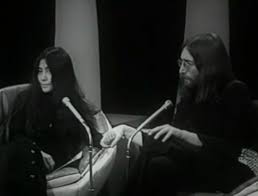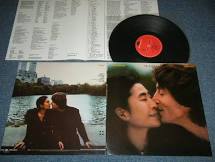Today John Lennon gave an exclusive interview to Alan Smith that would be published in the December 13th issue of the New Musical Express. The article would be entitled 'Beatles are on the Brink of Splitting' and features intriguing insights into John Lennon's early thoughts about what is troubling the group.
John cites several factors on the band's disharmony that he feels could potentially lead to a Beatles breakup, including differences of opinion on how to run Apple between himself and Paul, as well as George Harrison's budding songwriting talents making future Beatles releases less interesting to the Lennon/McCartney songwriting partnership. John says "I don’t want to spend six months making an album I have two tracks on. And neither do Paul or George probably."
He goes on to say that the Beatles future "...depends how much we all want to record together. I go off and on it. I really do."
Lennon also describes what he terms as the "freeloading" at Apple and says it needs to stop.
John gets in a plug for the release of his solo album, "Live Peace In Toronto" which had been released one day earlier on December 12th.
The breakup of the Beatles would be officially announced four months later, in April of 1970.
I MAY be wrong, and I hope I am, but these are dark days for the Beatles. I begin to wonder how much longer their association can stand the strain of their own individual talent.
John Lennon pulls toward peace and his own Plastic Ono Band; Ringo pulls toward a bigger and better film career; George Harrison jumps toward his own prolific songwriting; and Paul McCartney pulls himself away to Scotland, his own songs… and silence.
Certainly, John and Paul are on opposite sides of a heavy wall of difference and self-inflicted gloom. And the bond between them can hardly have been more weak, or their opposing interests more strong.
A few days ago, John and Yoko and I in a one-hour and fifteen minute exclusive interview for NME, (partly filmed for BBC-1’s look at the world of John and Yoko Lennon in “24 Hours”), and during that time he gave me frank answers to his mental rifts with Paul and the current state of the Beatles.
He was pleasant, together, straightforward, mellow and resolute, and only in references to Paul did his voice drop in doubt.
He told me “Paul and I have differences of opinion on how things should be run. But instead of it being a private argument about how an LP should be done, or a certain track, it’s now a larger argument about the organization of Apple itself.”
“Whether we both want the same thing from Apple in the end is a matter of opinion. But how to achieve it -- that’s where we digress.
“Mainly we disagree on the Klein bit. But you know, I don’t really want to discuss Paul without him here. It’s just that as far as I can see, Paul was always waiting for this guy to just appear and save us from the mess we were in.
“And we were in a mess, and only my saying it in the press that time enabled Klein to hear about it and come over.
“I’m a quarter of this building, and it became a question of whether I should pull my money out if I could – which I probably can’t.
“I did say I wanted out at one time. It was just that all my income was going into Apple and being wasted by the joy-riding people who were here. In fact, that was just the minute bit of it. I just wanted it to stop.
“It’s no use pretending we can be here all the time when that kind of thing is going on. We needed a business man. No Beatle can spend his days here checking the accountants.
“There was also the question of the four of us holding different opinions on things, and the staff not knowing where they were or who to listen to.
“I know that’s what’s going on all the time. People come to me and say ‘Paul wants this done. What do you think?’ and they know damn well what I think, and they say ‘Alright,’ and then they go to Paul and say ‘John wants this done. He’s off again.’
“The result is that we kept sending in different instructions and nothing was being done. Like people anywhere, they were getting away with what they could. We were naïve and stupid.
“What I would like is for the freeloading to stop but the old Apple spirit to remain. The spirit will be there, because if Apple is not a problem to the Beatles – which it was – it just can’t help but get better.
“Our job is to put the creative side into Apple. If the Beatles never recorded together again, but each put their creative efforts through Apple… that at least would be better than me having a company, Paul having a company, George having a company, and Ringo having a company. Together we at least have that much more power.
“I know now that the original concept of helping everybody doesn’t work in its purest form. All you get are the bums and freeloaders everybody else turns down.
“The only way we can help other artists at Apple is the same way the Beatles helped other artists… by breaking new barriers. That’s what we didn’t get before. We sat back, and we started to believe our own publicity, to tell ourselves how the Beatles helped people get long hair, and the Beatles started off this, and the other.
“The Beatles split up? It just depends how much we all want to record together. I don’t know if I want to record together again. I go off and on it. I really do.
“The problem is that in the old days, when we needed an album, Paul and I got together and produced enough songs for it. Nowadays there’s three if us writing prolifically and trying to fit it all onto one album. Or we have to think of a double album every time, which takes six months.
“That’s the hang-up we have. It’s not a personal ‘The Beatles are fighting’ thing, so much as an actual physical problem. What do you do? I don’t want to spend six months making an album I have two tracks on. And neither do Paul or George probably. That’s the problem. If we can overcome that, maybe it’ll sort itself out.
“None of us want to be background musicians most of the time. It’s a waste. We didn’t spend ten years ‘making it’ to have the freedom in the recording studios, to be able to have two tracks on an album.
“It’s not like we spend our time wrestling in the studio trying to get our own songs on. We all do it the same way… we take it in turns to record a track. It’s just that usually in the past, George lost out because Paul and I are tougher.
“It’s nothing new, the way things are. It’s human. We’ve always said we’ve had fights. It’s no news that we argue. I’m more interested in my songs. Paul’s more interested in his, and George is more interested in his. That’s always been.
“This is why I’ve started with the Plastic Ono and working with Yoko… to have more outlet. There isn’t enough outlet for me in the Beatles. The Ono Band is my escape valve. And how important that gets, as compared to the Beatles for me, I’ll have to wait and see.
“You have to realize that there’s a peculiar situation, in that if ‘Cold Turkey’ had the name Beatles on it, probably it would have been a No. 1.
“ ‘Cold Turkey’ has got Ringo and me on it, and yet on half the Beatles’ tracks of ‘Abbey Road,’ I’m not on, or half the tracks on the double album – and even way back. Sometimes there might be only two Beatles on a track. It’s got to the situation where if we have the name ‘Beatle’ on it, it sells. So you get to think: ‘What are we selling? Do they buy it because it’s worth it, or just because it says ‘Beatles’?
“George is in the same position. I mean, he’s got songs he’s been trying to get on since 1930. He’s got to make an album of his own. And maybe if he puts ‘Beatles’ on the label rather than George Harrison, it might sell more. That’s the drag.
“Of course we could each make an album and call it ‘The Beatles,’ but that would be cheating. And that’s not my scene.
“Anyway, folks, remember the Plastic Ono Band LP from Toronto released December the 13th, with a nice picture of the sky, and a fab calendar inside of a year’s events with John and Yoko, with poetry and fun.”
NEXT WEEK: “DO I WANT TO BE HATED”; MISCARRIAGE; THE ‘GET BACK’ FILM; STAGE FRIGHT; AUNT MIMI; FEAR; INSECURITY; JEALOUSY; POLITICIANS – AND PEACE.










